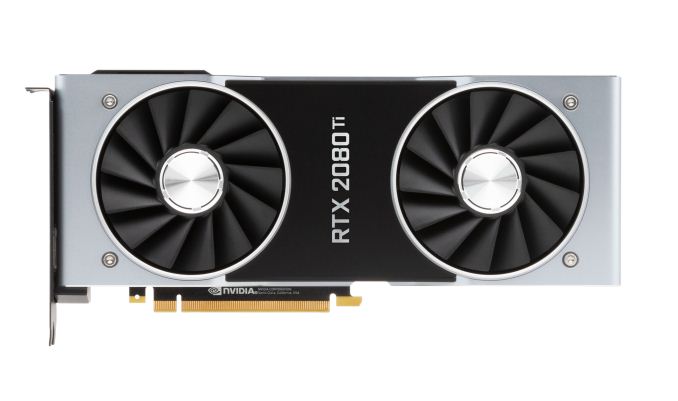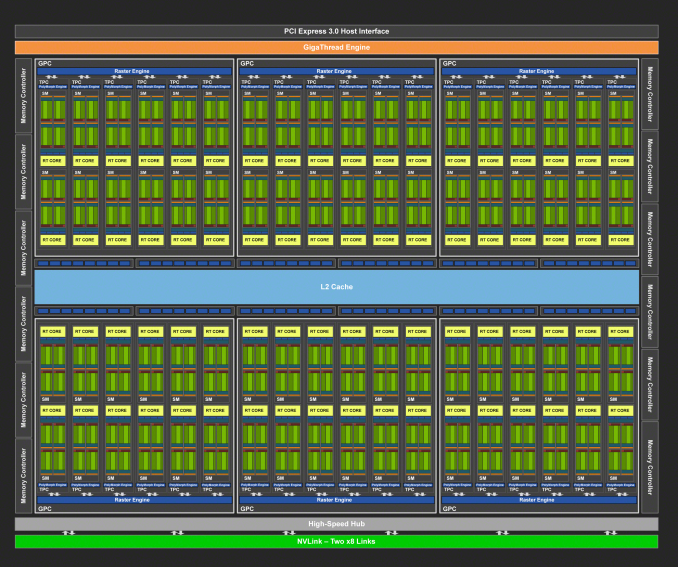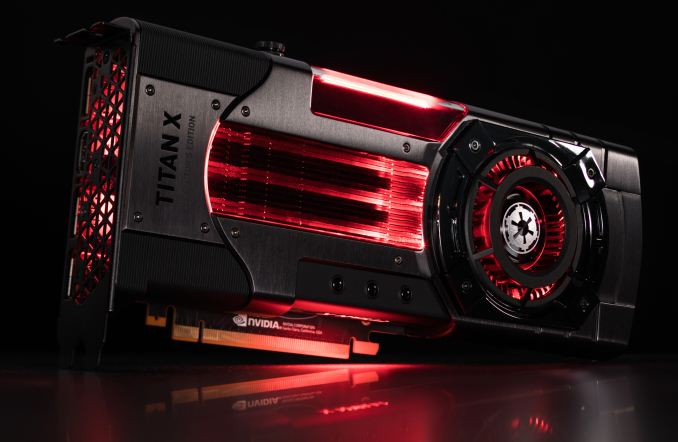The NVIDIA GeForce RTX 2080 Ti & RTX 2080 Founders Edition Review: Foundations For A Ray Traced Future
by Nate Oh on September 19, 2018 5:15 PM EST- Posted in
- GPUs
- Raytrace
- GeForce
- NVIDIA
- DirectX Raytracing
- Turing
- GeForce RTX

While it was roughly 2 years from Maxwell 2 to Pascal, the journey to Turing has felt much longer despite a similar 2 year gap. There’s some truth to the feeling: looking at the past couple years, there’s been basically every other possible development in the GPU space except next-generation gaming video cards, like Intel’s planned return to discrete graphics, NVIDIA’s Volta, and cryptomining-specific cards. Finally, at Gamescom 2018, NVIDIA announced the GeForce RTX 20 series, built on TSMC’s 12nm “FFN” process and powered by the Turing GPU architecture. Launching today with full general availability is just the GeForce RTX 2080, as the GeForce RTX 2080 Ti was delayed a week to the 27th, while the GeForce RTX 2070 is due in October. So up for review today is the GeForce RTX 2080 Ti and GeForce RTX 2080.
But a standard new generation of gaming GPUs this is not. The “GeForce RTX” brand, ousting the long-lived “GeForce GTX” moniker in favor of their announced “RTX technology” for real time ray tracing, aptly underlines NVIDIA’s new vision for the video card future. Like we saw last Friday, Turing and the GeForce RTX 20 series are designed around a set of specialized low-level hardware features and an intertwined ecosystem of supporting software currently in development. The central goal is a long-held dream of computer graphics researchers and engineers alike – real time ray tracing – and NVIDIA is aiming to bring that to gamers with their new cards, and willing to break some traditions on the way.
| NVIDIA GeForce Specification Comparison | ||||||
| RTX 2080 Ti | RTX 2080 | RTX 2070 | GTX 1080 | |||
| CUDA Cores | 4352 | 2944 | 2304 | 2560 | ||
| Core Clock | 1350MHz | 1515MHz | 1410MHz | 1607MHz | ||
| Boost Clock | 1545MHz FE: 1635MHz |
1710MHz FE: 1800MHz |
1620MHz FE: 1710MHz |
1733MHz | ||
| Memory Clock | 14Gbps GDDR6 | 14Gbps GDDR6 | 14Gbps GDDR6 | 10Gbps GDDR5X | ||
| Memory Bus Width | 352-bit | 256-bit | 256-bit | 256-bit | ||
| VRAM | 11GB | 8GB | 8GB | 8GB | ||
| Single Precision Perf. | 13.4 TFLOPs | 10.1 TFLOPs | 7.5 TFLOPs | 8.9 TFLOPs | ||
| Tensor Perf. (INT4) | 430TOPs | 322TOPs | 238TOPs | N/A | ||
| Ray Perf. | 10 GRays/s | 8 GRays/s | 6 GRays/s | N/A | ||
| "RTX-OPS" | 78T | 60T | 45T | N/A | ||
| TDP | 250W FE: 260W |
215W FE: 225W |
175W FE: 185W |
180W | ||
| GPU | TU102 | TU104 | TU106 | GP104 | ||
| Transistor Count | 18.6B | 13.6B | 10.8B | 7.2B | ||
| Architecture | Turing | Turing | Turing | Pascal | ||
| Manufacturing Process | TSMC 12nm "FFN" | TSMC 12nm "FFN" | TSMC 12nm "FFN" | TSMC 16nm | ||
| Launch Date | 09/27/2018 | 09/20/2018 | 10/2018 | 05/27/2016 | ||
| Launch Price | MSRP: $999 Founders $1199 |
MSRP: $699 Founders $799 |
MSRP: $499 Founders $599 |
MSRP: $599 Founders $699 |
||
As we discussed at the announcement, one of the major breaks is that NVIDIA is introducing GeForce RTX as the full upper tier stack with x80 Ti/x80/x70 stack, where it has previously tended towards the x80/x70 products first, and the x80 Ti as a mid-cycle refresh or competitive response. More intriguingly, each GeForce card has their own distinct GPU (TU102, TU104, and TU106), with direct Quadro and now Tesla variants of TU102 and TU104. While we covered the Turing architecture in the preceding article, the takeaway is that each chip is proportionally cut-down, including the specialized RT Cores and Tensor Cores; with clockspeeds roughly the same as Pascal, architectural changes and efficiency enhancements will be largely responsible for performance gains, along with the greater bandwidth of 14Gbps GDDR6.
And as far as we know, Turing technically did not trickle down from a bigger compute chip a la GP100, though at the architectural level it is strikingly similar to Volta/GV100. Die size brings more color to the story, because with TU106 at 454mm2, the smallest of the bunch is frankly humungous for a FinFET die nominally dedicated for a x70 GeForce product, and comparable in size to the 471mm2 GP102 inside the GTX 1080 Ti and Pascal Titans. Even excluding the cost and size of enabled RT Cores and Tensor Cores, a slab of FinFET silicon that large is unlikely to be packaged and priced like the popular $330 GTX 970 and still provide the margins NVIDIA is pursuing.
These observations are not so much to be pedantic, but more so to sketch out GeForce Turing’s positioning in relation to Pascal. Having separate GPUs for each model is the most expensive approach in terms of research and development, testing, validation, extra needed fab tooling/capacity – the list goes on. And it raises interesting questions on the matter of binning, yields, and salvage parts. Though NVIDIA certainly has the spare funds to go this route, there’s surely a better explanation than Turing being primarily designed for a premium-priced consumer product that cannot command the margins of professional parts. These all point to the known Turing GPUs as oriented for lower-volume, and NVIDIA’s financial quarterly reports indicate that GeForce product volume is a significant factor, not just ASP.
And on that note, the ‘reference’ Founders Edition models are no longer reference; the GeForce RTX 2080 Ti, 2080, and 2070 Founders Editions feature 90MHz factory overclocks and 10W higher TDP, and NVIDIA does not plan to productize a reference card themselves. But arguably the biggest change is the move from blower-style coolers with a radial fan to an open air cooler with dual axial fans. The switch in design improves cooling capacity and lowers noise, but with the drawback that the card can no longer guarantee that it can cool itself. Because the open air design re-circulates the hot air back into the chassis, it is ultimately up to the chassis to properly exhaust the heat. In contrast, a blower pushes all the hot air through the back of the card and directly out of the case, regardless of the chassis airflow or case fans.
All-in-all, NVIDIA is keeping the Founders Edition premium, which is now $200 over the baseline ‘reference.’ Though AIB partner cards are also launching today, in practice the Founders Edition pricing is effectively the retail price until the launch rush has subsided.
The GeForce RTX 20 Series Competition: The GeForce GTX 10 Series
In the end, the preceding GeForce GTX 10 series ended up occupying an odd spot in the competitive landscape. After its arrival in mid-2016, only the lower end of the stack had direct competition, due to AMD’s solely mainstream/entry Polaris-based Radeon RX 400 series. AMD’s RX 500 series refresh in April 2017 didn’t fundamentally change that, and it was only until August 2017 that the higher-end Pascal parts had direct competition with their generational equal in RX Vega. But by that time, the GTX 1080 Ti (not to mention the Pascal Titans) was unchallenged. And all the while, an Ethereum-led resurgence of mining cryptocurrency on video cards was wreaking havoc on GPU pricing and inventory, first on Polaris products, then general mainstream parts, and finally affecting any and all GPUs.
Not that NVIDIA sat on their laurels with Vega, releasing the GTX 1070 Ti anyhow. But what was constant was how the pricing models evolved with the Founders Editions schema, the $1200 Titan X (Pascal), and then $700 GTX 1080 Ti and $1200 Titan Xp. Even the $3000 Titan V maintained gaming cred despite diverging greatly from previous Titan cards as firmly on the professional side of prosumer, basically allowing the product to capture both prosumers and price-no-object enthusiasts. Ultimately, these instances coincided with the rampant cryptomining price inflation and was mostly subsumed by it.
So the higher end of gaming video cards has been Pascal competing with itself and moving up the price brackets. For Turing, the GTX 1080 Ti has become the closest competitor. RX Vega performance hasn’t fundamentally changed, and the fallout appears to have snuffed out any Vega 10 parts, as well as Vega 14nm+ (i.e. 12nm) refreshes. As a competitive response, AMD doesn’t have many cards up their sleeves except the ones already played – game bundles (such as the current “Raise the Game” promotion), FreeSync/FreeSync 2, other hardware (CPU, APU, motherboard) bundles. Other than that, there’s a DXR driver in the works and a machine learning 7nm Vega on the horizon, but not much else is known, such as mobile discrete Vega. For AMD graphics cards on shelves right now, RX Vega is still hampered by high prices and low inventory/selection, remnants of cryptomining.
For the GeForce RTX 2080 Ti and 2080, NVIDIA would like to sell you the RTX cards as your next upgrade regardless of what card you may have now, essentially because no other card can do what Turing’s features enable: real time raytracing effects ((and applied deep learning) in games. And because real time ray tracing offers graphical realism beyond what rasterization can muster, it’s not comparable to an older but still performant card. Unfortunately, none of those games have support for Turing’s features today, and may not for some time. Of course, NVIDIA maintains that the cards will provide expected top-tier performance in traditional gaming. Either way, while Founders Editions are fixed at their premium MSRP, custom cards are unsurprisingly listed at those same Founders Edition price points or higher.
| Fall 2018 GPU Pricing Comparison | |||||
| AMD | Price | NVIDIA | |||
| $1199 | GeForce RTX 2080 Ti | ||||
| $799 | GeForce RTX 2080 | ||||
| $709 | GeForce GTX 1080 Ti | ||||
| Radeon RX Vega 64 | $569 | ||||
| Radeon RX Vega 56 | $489 | GeForce GTX 1080 | |||
| $449 | GeForce GTX 1070 Ti | ||||
| $399 | GeForce GTX 1070 | ||||
| Radeon RX 580 (8GB) | $269/$279 | GeForce GTX 1060 6GB (1280 cores) |
|||













337 Comments
View All Comments
Qasar - Wednesday, September 19, 2018 - link
just checked a local store, the lowest priced 2080 card, a gigabyte rtx 2080 is $1080, and thats canadian dollars... the most expensive RTX card ..EVGA RTX 2080 Ti XC ULTRA GAMING 11GB is $1700 !!!! again that's canadian dollars !! to make things worse.. that's PRE ORDER pricing, and have this disclaimer : Please note that the prices of the GeForce RTX cards are subject to change due to FX rate and the possibility of tariffs. We cannot guarantee preorder prices when the stock arrives - prices will be updated as needed as stock become available.even if i could afford these cards.. i think i would pass.. just WAY to expensive.. id prob grab a 1080 or 1080ti and be done with it... IMO... nvida is being a tad bit greedy just to protect and keep its profit margins.. but, they CAN do this.. cause there is no one else to challenge them...
PopinFRESH007 - Wednesday, September 19, 2018 - link
would you care to share the bill of materials for the tu102 chip? Since you seem to suggest you know the production costs, and therefor know the profit margin which you suggest is a bit greedy.Qasar - Wednesday, September 19, 2018 - link
popin.. all i am trying to say is nvidia doesnt have to charge the prices they are charging.. but they CAN because there is nothing else out there to provide competition...tamalero - Thursday, September 20, 2018 - link
Please again explain how the cost of materials is somehow relevant on the price performance argument for consumers?Chips like R600, Fermi, similars.. were huge.. did it matter? NO, did performance matter? YES.
PopinFRESH007 - Thursday, September 20, 2018 - link
I specifically replied to Qasar's claim "nvida is being a tad bit greedy just to protect and keep its profit margins.. but, they CAN do this" which is baseless unless they have cost information to know what their profit margins are.Nagorak - Thursday, September 20, 2018 - link
Nvidia is a public company. You can look up their profit margin and it is quite high.Qasar - Thursday, September 20, 2018 - link
PopinFRESH * sigh * i guess you will never understand the concept of " no competition, we can charge what ever we want, and people will STILL buy it cause it is the only option if you want the best or fastest " it has NOTHING to do with knowing cost info or what a companies profit margins are... but i guess you will never understand this....just4U - Thursday, September 20, 2018 - link
Ofcourse their being greedy. Since they saw their cards flying off the shelfs at 50% above MSRP earlier this year they know people are willing to pay.. so their pushing the limit. As they normally do.. this isn't new with Nvidia. Not sure why any are defending them.. or getting excessively mad about it. (..shrug)mapesdhs - Wednesday, September 26, 2018 - link
Effectively, gamers are complaining about themselves. Previous cards sold well at higher prices, so NVIDIA thinks it can push up the pricing further, and reduce product resources at the same time even when the cost is higher. If the cards do sell well then gamers only have themselves to blame, in which case nothing will change until *gamers* stop making it fashionable and cool to have the latest and greatest card. Likewise, if AMD does release something competitive, whether via price, performance or both, then gamers need to buy the damn things instead of just exploiting the lowered NVIDIA pricing as a way of getting a cheaper NVIDIA card. There's no point AMD even being in this market if people don't buy their products even when it does make sense to do so.BurntMyBacon - Thursday, September 20, 2018 - link
@PopinFRESH007: "would you care to share the bill of materials for the tu102 chip? Since you seem to suggest you know the production costs, and therefor know the profit margin which you suggest is a bit greedy."You have a valid point. It is hard to establish a profit margin without a bill of materials (among other things). We don't have a bill of materials, but let me establish some knowns so we can better assess.
Typically, most supporting components on a graphics card are pretty similar to previous generation cards. Often times different designs used to do the same function are a cost cutting measure. I'm going to make an assumption that power transistors, capacitors, output connectors, etc. will remain nominally the same cost. So I'll focus on differences. The obvious is the larger GPU. This is not the first chip made on this process (TSMC 12nm) and the process appears to be a half node, so defect rates should be lower and the wafer cost should be similar to TSMC 14nm. On the other hand, the chip is still very large which will likely offset some of that yield gain and reduce the number of chips fabricated per wafer. Pascal was first generation chip produced on a new full node process (TSMC 14nm), but quite a bit smaller, so yields may have been higher and there were more chips fabricated per wafer. Also apparent is the newer GDDR6 memory tech, which will naturally cost more than GDDR5(X) at the moment, but clearly not as much as HBM2. The chips also take more power, so I'd expect a marginal increase for power related circuitry and cooling relative to pascal. I'd expect about the same cost here as for maxwell based chips, given similar power requirements.
From all this, it sounds like graohics cards based on Turing chips will cost more to manufacture than Pascal equivalents. I it is probably not unreasonable to suggest that a TU106 may have a similar cost bill of materials to a GP102 with the note that the cost to produce the GP102 has most certainly dropped since introduction.
I'll leave the debate on how greedy or not this is to others.